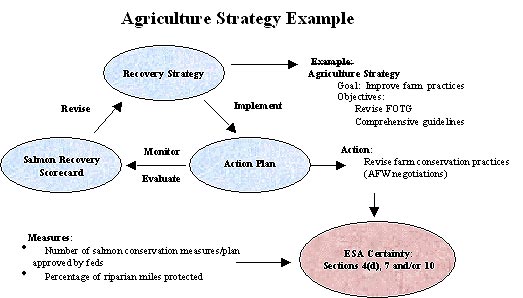A Report to the Legislature
Submitted by the
Office of the Governor
in fulfillment of requirements
in RCW 77.85.020

December 2000
THE STATE OF SALMON
A Report to the Legislature
Submitted by the
Office of the Governor
in fulfillment of requirements
in RCW 77.85.020

December 2000
Background
The Salmon Recovery Planning Act (ESSB 2496), passed in 1998, requires the Governor's Salmon Recovery Office to submit a "state of salmon" report biennially, beginning in December 2000. That report is presented here, in four parts that together capture important activities the Governor's Office and state agencies have undertaken to recover salmon.
Included are the three major documents we produced in the last two years, plus the new twenty-four page The State of Salmon report, our first publication designed for a broad, citizen audience. It captures our goals, challenges and progress in salmon recovery. It tells the state's salmon recovery story to date through maps, photos and other graphics, and even offers tips on what people can do at home and in their own back yard to make a difference - not just for salmon, but for themselves. A copy of The State of Salmon is also included in this package.
Every two years we will report on the progress we have made in reversing the decline of salmon, and the challenges we face in achieving recovery.
The Governor's Salmon Recovery Office was formally created in July 1998. Initially, one of the most frustrating organizational issues facing us was just the number of government agencies involved in salmon recovery. There are two countries, six states, and twenty-eight tribes. At the federal level, six departments, some with more than one branch, have some jurisdiction with this issue. In our state, fourteen agencies (about half directly reporting to the governor, and half not) participate in salmon issues. At the local level the issue is even more staggering: 39 counties, 277 cities, 44 sewer districts, 125 water districts, 36 irrigation districts, 32 public utility districts, 14 port districts, 48 conservation districts, and 170 municipal water suppliers all have some impact and/or responsibility in salmon recovery. As a result, our role in state government touches more than 800 government jurisdictions and agencies that play some part in salmon recovery. This leads to a complex and time-consuming process of coordination.
To coordinate the state's efforts, Governor Gary Locke brought the state agencies together that most affect salmon management to form the Joint Natural Resources Cabinet. This cabinet of 12 agency directors has created the documents that guide salmon recovery at the state level.
The Salmon Recovery Documents
All attachments are also posted on our Web site at www.governor.wa.gov/gsro.
How the Pieces Fit Together
The three recovery documents collectively chart our course in bringing back salmon and meeting the requirements of the Endangered Species Act. They complete a resource planning and implementation cycle in the following way:

In this example, the Strategy lists goals (improve farm practices) and objectives (revise the Field Office Technical Guidelines and Comprehensive Farm Plan guidelines) for agriculture. The priority actions chosen for the 1999-2001 biennium, listed in the State Agencies' Action Plan, are to revise these guidelines and practices through negotiation in the Agriculture, Fish, and Water process. We will monitor implementation of the completed guidelines through two measures from the Salmon Recovery Scorecard. We will also seek ESA certainty from the US Fish and Wildlife Service and National Marine Fisheries Service.
Conclusion
We recognize the process of salmon recovery is - and will continue to be - dynamic as well as difficult. Careful monitoring and a commitment to make changes as information is gathered are essential. And, most importantly, it will take all levels of government, business, and the public working together if we are to be successful.